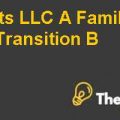
Harnischfeger Corporation
Background
The report presents a case where Harnischfeger Corporation, a leading producer of construction, mining and electrical equipments suffered a significant drop in the demand of company’s product due to worldwide recession in 1980s that significantly threatens the financial stability of the company. Harnischfeger Corporation (HC) in order to survive in this critical situation decides to restructure its strategy for forthcoming years. Some of the major strategies adopted are changes in top management, cost reductions to lower the break-even point, re-orientation of the company’s business, debt re-structuring and re-capitalization.
Effects of change in accounting policies and accounting estimates
Changes in accounting policies and accounting estimates have a significant impact on reported profit. Some of the key accounting policies and accounting estimates changes by Harnischfeger in its financial statements includes the following:
- The company previously uses accelerated depreciation method on its capital assets but the company now uses straight line depreciation method, such change in accounting policy increases the reported net income by $11 million.
- The company also changes accounting estimates to predict the lives of certain US plant and machinery along with their residual value, which increase the net income by $3.2 million
- Some of the foreign subsidiaries having year ended on 31 July are consolidated in HC financial statements at 31st October. Such change had an effect of increasing net sales by $5.4 million.
- The company also changes its accounting policy to value inventory. HC currently uses LIFO method to value its inventory whereas, FIFO method for inventories of foreign subsidiary. The effect of these liquidation increases the current net income by $2.4 million.
- The Retirement Plan of salaried employees was also restructured in 1984 due to overfunding of the plan. The effect of such changes in investment return assumption rates reduces the pension expense by approximately $4 million in 1984.
Management’s motive for changes in financial reporting policies
The management uses aggressive financial reporting policies which have a significant impact on the organization’s profit. This might be due to fact that the company wishes to show better financial performance in order to revise its loan terms or to be eligible to the recent incentive plan executed by the board of directors. Such plan provides an incentive compensation opportunity to 11 senior executive officers of 40% of annual salary, if the corporation reaches a specific net after profit objective. The plan will also provide an additional incentive compensation of 40% of annual salary to seven of those officers, if the corporation exceeds the profit.
The change in accounting policy of depreciable assets will increase the net profit by $11 million whereas the change in accounting estimate of the lives of depreciable assets will increase the profit by $3.2 million. Additionally, the effect of changes in the inventory valuation policy will increase the net income by $2.4 million.
All of the above policies and estimates adopted by management will increase the firm’s reported profit. Further the substantial reduction in expense regarding the retirement plan will....................
This is just a sample partial case solution. Please place the order on the website to order your own originally done case solution.
The analysis of the quality of Harnischfeger income and investment potential of the company in light of the rotation strategy. "Hide
by Krishna G. Palepu Source: Harvard Business School 23 pages. Publication Date: November 27, 1985. Prod. #: 186160-PDF-ENG













